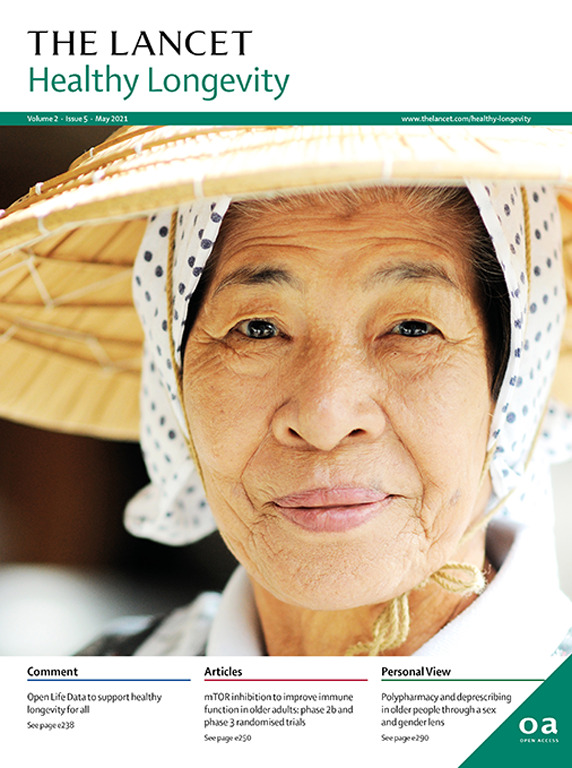Trends in mortality in people with heart failure and atrial fibrillation: a population-based cohort study
IF 14.6
Q1 GERIATRICS & GERONTOLOGY
引用次数: 0
Abstract
Background
Atrial fibrillation and heart failure frequently coexist but the relative effect of atrial fibrillation on survival in people with heart failure, and vice versa, remains uncertain. We aimed to report contemporary estimates of mortality among people with atrial fibrillation and heart failure and analyse trends in mortality over time.
Methods
We did a retrospective cohort study of adults aged 45 years or older in England, using primary care data from the Clinical Practice Research Datalink GOLD dataset and linked secondary care data (Hospital Episode Statistics and Office for National Statistics datasets), for a total follow-up period from Jan 1, 2000, to Dec 31, 2018. We recorded incident cases of heart failure and atrial fibrillation in primary or secondary care during the study period, as well as pre-existing cases at the study index date. Individuals were categorised as having both heart failure and atrial fibrillation, atrial fibrillation only, heart failure only, or neither condition, with heart failure and atrial fibrillation included in analyses as time-varying covariates. The primary outcome was all-cause mortality, as recorded in primary or secondary care. We report the incidence and hazard ratios for all-cause mortality by diagnosis status, median overall survival following diagnosis, and the cumulative probability of all-cause mortality from 3 months to 10 years of follow-up and by year of diagnosis to assess trends over time. Estimates of median survival and the cumulative probability of overall mortality were restricted to incident diagnoses during the study period, and calculated overall as well as by sex, age, and Index of Multiple Deprivation quintile.
Findings
The cohort consisted of 2 381 941 people, including 100 132 initially diagnosed with heart failure only and 155 061 initially diagnosed with atrial fibrillation only by the study index date or during follow-up. By the end of follow-up, 74 470 people had been diagnosed with both conditions. 314 042 people died during follow-up, including 42 427 (57·0%) of those diagnosed with both heart failure and atrial fibrillation. In people diagnosed with both conditions during the study period (n=43 714), median overall survival was 3·15 years (95% CI 3·08–3·21), and the cumulative probability of mortality was 31·8% (95% CI 30·2–33·6) at 1 year, 61·4% (59·4–63·3) at 5 years, and 80·2% (78·3–82·1) at 10 years after both conditions had been diagnosed, representing significantly worse rates than for an initial diagnosis of either condition alone. Similarly, the risk-adjusted hazard of all-cause mortality was highest among people with both heart failure and atrial fibrillation. For the overall population, cumulative mortality probability estimates were unchanged over successive years of diagnosis for people with both heart failure and atrial fibrillation, while showing small improvements for people initially diagnosed with heart failure only (median reduction in 10-year cumulative probability of 3·8% [95% CI 1·4–6·1] between diagnosis years 2000 and 2008) or atrial fibrillation only (median reduction in 1-year cumulative mortality probability of 2·4% [0·5–4·2] between diagnosis years 2000 and 2017) and improvement over the long-term for people diagnosed with both conditions before age 65 years (median reduction in 10-year cumulative mortality probability of 14·5% [95% CI 3·8–25·2] between diagnosis years 2000 and 2008). For people with both conditions, median overall survival was significantly longer in the least deprived quintile (3·46 years [95% CI 3·31–3·59]; n=9275) than in the most deprived quintile (2·67 years [2·51–2·81]; n=6302). Median overall survival in each exposure group was similar between sexes after stratifying for age.
Interpretation
Comorbid heart failure and atrial fibrillation was common and prognosis was poor, with no improvement in mortality estimates for diagnoses over time, and the worst survival in socially deprived groups.
Funding
Wellcome Trust and the National Institute for Health and Care Research Collaboration for Leadership in Applied Health Research and Care Oxford.
心力衰竭和心房颤动患者死亡率的趋势:一项基于人群的队列研究。
背景:心房颤动和心力衰竭经常共存,但心房颤动对心力衰竭患者生存的相对影响,反之亦然,仍不确定。我们的目的是报告心房颤动和心力衰竭患者的当代死亡率估计,并分析死亡率随时间的趋势。方法:我们对英国45岁及以上的成年人进行了回顾性队列研究,使用临床实践研究数据链GOLD数据集的初级保健数据和相关的二级保健数据(医院事件统计和国家统计局数据集),总随访期为2000年1月1日至2018年12月31日。我们记录了在研究期间在初级或二级护理中发生的心力衰竭和心房颤动的病例,以及在研究索引日期已存在的病例。个体被归类为既有心力衰竭又有心房颤动,只有心房颤动,只有心力衰竭,或两者都没有,心力衰竭和心房颤动作为时变协变量包括在分析中。主要结局是记录在初级或二级保健中的全因死亡率。我们报告了全因死亡率的发生率和风险比,包括诊断状态、诊断后的中位总生存率,以及随访3个月至10年的全因死亡率累积概率和诊断年份,以评估随时间推移的趋势。中位生存期和总死亡率累积概率的估计仅限于研究期间的事件诊断,并根据总体以及性别、年龄和多重剥夺指数五分位数进行计算。研究结果:该队列包括2 381 941人,其中100132人最初诊断为心力衰竭,155 061人最初诊断为心房颤动,仅在研究索引日期或随访期间。到随访结束时,有74 470人被诊断出患有这两种疾病。随访期间死亡314042人,其中42427人(57.0%)同时诊断为心力衰竭和心房颤动。在研究期间(n=43 714)诊断为这两种疾病的患者中,中位总生存期为3.15年(95% CI 3.08 - 3.21),两种疾病诊断后1年的累积死亡率为31.8% (95% CI 30.2 - 33.6), 5年的累积死亡率为64.1%(59.4 - 63.3),10年的累积死亡率为80.2%(78.3 - 82.1),明显低于单独诊断任何一种疾病的患者。同样,经风险调整后的全因死亡率在心力衰竭和心房颤动患者中最高。对于总体人群来说,对于心力衰竭和心房颤动患者的累积死亡率估计在连续几年的诊断中没有变化,而对于最初诊断为心力衰竭的患者(2000年至2008年诊断年期间10年累积概率中位数降低3.8% [95% CI 1.4 - 6.1])或仅心房颤动(2000年至2017年诊断年期间1年累积死亡率中位数降低2.4%[0.5 - 4.2]),以及65岁之前诊断为两种疾病的患者的长期改善(10年累积死亡率中位数降低)2000年和2008年诊断年份之间的概率为14.5% [95% CI 3.8 - 25.2])。对于两种情况的患者,最贫困五分位数的中位总生存期明显更长(3.46年[95% CI 3.31 - 3.59];N =9275)比最贫困五分位数(2.67岁[2.51 ~ 2.81])多;n = 6302)。在年龄分层后,每个暴露组的中位总生存率在性别之间相似。解释:合并症心衰和房颤很常见,预后很差,随着时间的推移,诊断的死亡率估计没有改善,社会剥夺群体的生存率最差。资助:惠康信托基金会和国家健康与护理研究合作研究所,领导牛津大学的应用健康研究和护理。
本文章由计算机程序翻译,如有差异,请以英文原文为准。
求助全文
约1分钟内获得全文
求助全文
来源期刊

Lancet Healthy Longevity
GERIATRICS & GERONTOLOGY-
CiteScore
16.30
自引率
2.30%
发文量
192
审稿时长
12 weeks
期刊介绍:
The Lancet Healthy Longevity, a gold open-access journal, focuses on clinically-relevant longevity and healthy aging research. It covers early-stage clinical research on aging mechanisms, epidemiological studies, and societal research on changing populations. The journal includes clinical trials across disciplines, particularly in gerontology and age-specific clinical guidelines. In line with the Lancet family tradition, it advocates for the rights of all to healthy lives, emphasizing original research likely to impact clinical practice or thinking. Clinical and policy reviews also contribute to shaping the discourse in this rapidly growing discipline.
 求助内容:
求助内容: 应助结果提醒方式:
应助结果提醒方式:


